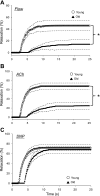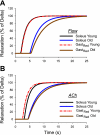Aging blunts the dynamics of vasodilation in isolated skeletal muscle resistance vessels
- PMID: 19797684
- PMCID: PMC2885069
- DOI: 10.1152/japplphysiol.00970.2009
Aging blunts the dynamics of vasodilation in isolated skeletal muscle resistance vessels
Abstract
Aging is associated with an altered ability to match oxygen delivery (QO2) to consumption ((.)VO2) in skeletal muscle and differences in the temporal profile of vasodilation may provide a mechanistic basis for the QO2-to-(.)VO2 mismatching during the rest-to-exercise transition. Therefore, we tested the hypothesis that the speed of vasodilation will be blunted in skeletal muscle first-order arterioles from old vs. young rats. Arterioles from the soleus and the red portion of the gastrocnemius (Gast(Red)) muscles were isolated from young (Y, 6 mo; n = 9) and old (O, 24 mo; n = 9) Fischer 344 rats and studied in vitro. Vessels were exposed to acetylcholine (ACh; 10(-6) M), sodium nitroprusside (SNP; 10(-4) M), and increased intraluminal flow, and the subsequent vasodilation was recorded at 30 frames/s. The data were fit to a monoexponential model and the dynamics of vasodilation [i.e., time delay, time constant (tau), and rate of change (delta/tau)] were calculated. With old age, the rate of vasodilation was significantly blunted in resistance vessels from the soleus to ACh (Y, 27.9 +/- 3.6; O, 8.8 +/- 2.6 microm/s) and flow (Y, 12.8 +/- 2.1; O, 3.1 +/- 0.9 microm/s). In the Gast(Red) the old age-associated impairment of endothelium-dependent vasodilator dynamics was even greater than that of the soleus. With SNP neither the magnitude nor time constant of vasodilation was affected by age in either muscle. The results indicate that aging impairs the dynamics of vasodilation in resistance vessels from the soleus and Gast(Red) muscles mediated, in part, through the endothelium. Thus the old age-associated slower rate and magnitude of vasodilation could inhibit the delivery of O2 during the critical transition from rest to exercise in moderate to highly oxidative skeletal muscle.
Figures





Comment in
-
Mechanistic insights into how advanced age moves the site of (.)VO2 kinetics limitation upstream.J Appl Physiol (1985). 2010 Jan;108(1):5-6. doi: 10.1152/japplphysiol.01237.2009. Epub 2009 Nov 5. J Appl Physiol (1985). 2010. PMID: 19892927 No abstract available.
References
-
- Armstrong RB, Laughlin MH. Metabolic indicators of fibre recruitment in mammalian muscles during locomotion. J Exp Biol 115: 201–213, 1985 - PubMed
-
- Barstow TJ, Mole PA. Simulation of pulmonary O2 uptake during exercise transients in humans. J Appl Physiol 63: 2253–2261, 1987 - PubMed
-
- Bearden SE. Advancing age produces sex differences in vasomotor kinetics during and after skeletal muscle contraction. Am J Physiol Regul Integr Comp Physiol 293: R1274–R1279, 2007 - PubMed
Publication types
MeSH terms
Substances
Grants and funding
LinkOut - more resources
Full Text Sources
Medical

